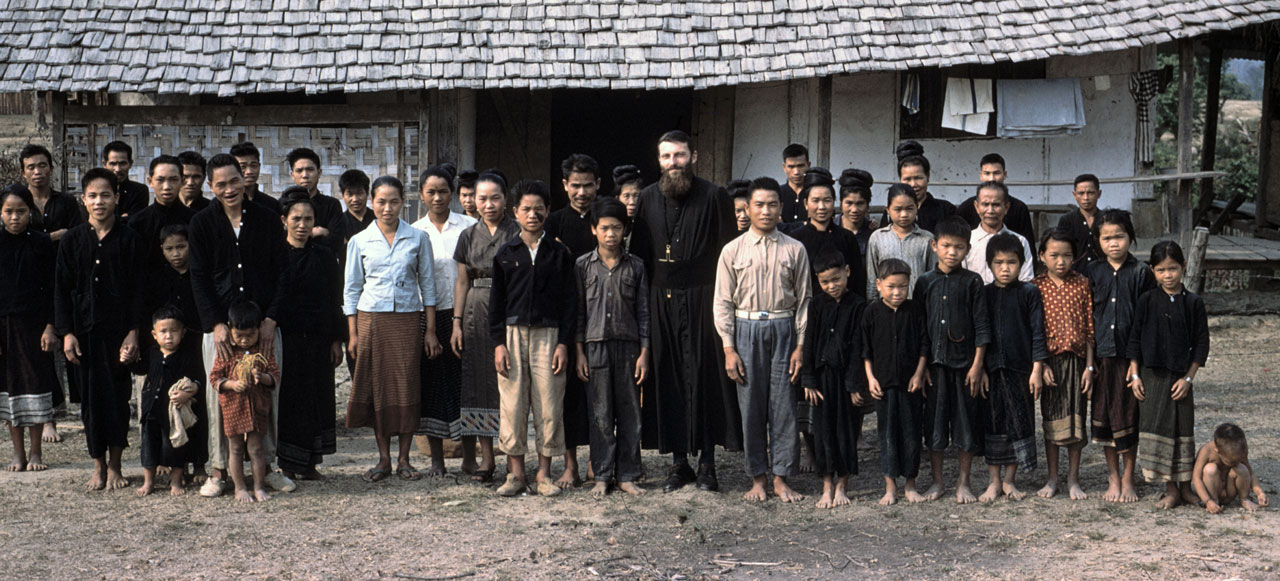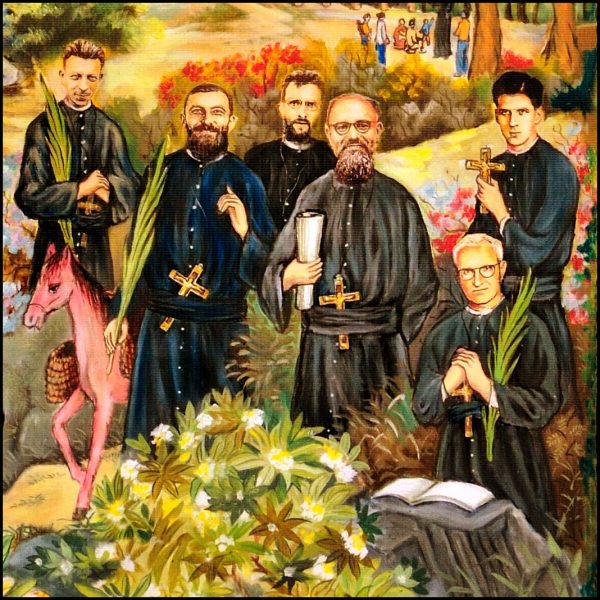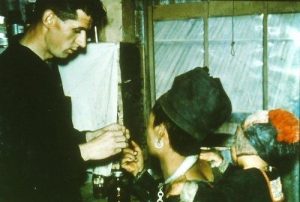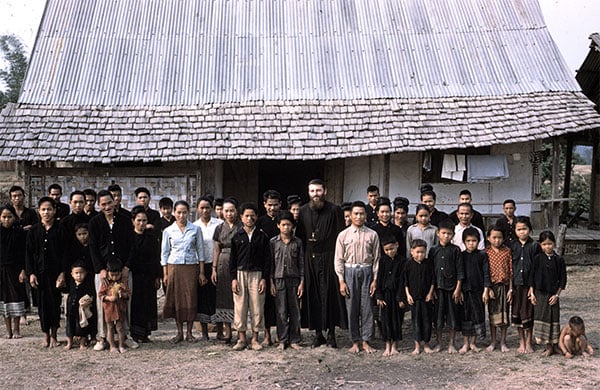Memorial: December 16
Click here to download the booklet “Oblates along the Mekong”
Click here to download the booklet “The First Witnesses of the Church in Laos”
Short Biographical Notes
Father Mario Borzaga
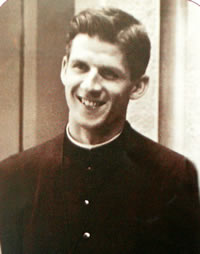
It was in that spirit that, in 1952, he began his year of novitiate with the Italian Missionary Oblates of Mary Immaculate in Molise. Then, from 1953-1957, he prepared himself for missionary life through several years of study at the Oblate Scholasticate, San Giorgio Canavese, near Torino. He was ordained a priest in 1957. The same year, the Oblates of Italy sent their first team of missionaries to Laos.
Arriving in one of the poorest countries in the world, with a small number of Christians, was a shock for him. He spent his first year in the mission of Kengsadok. There, he had to learn the language, the local culture and missionary life. He loved to be with the people; he wanted to learn everything from them as quickly as possible. In reality, it was a very difficult year. Mario Borzaga was 26 years old when he was sent to his first mission post. Kiukatiam was a Hmong village, some 80 km from Louang Prabang. Teaching catechism, teaching people how to pray, visiting families, receiving the sick people who daily gathered at the door of the mission dispensary: that is how Mario spent his time and his strength. He was also put in charge of the formation of young Hmong catechists.
On Sunday, April 24, 1960, after Mass, Mario was getting ready to treat the ill at the dispensary. A small group of Hmong presented themselves and asked him to come to their village, situated a three-day walk to the south. They said they were interested in religion. Mario Borzaga promised these people he would follow them the next day. His plan was to visit several villages in the same area and go up the Mekong valley to the west to Luang Prabang. He invited the young catechist, Xyooj, to go with him. On Monday, April 25, 1960, they set off. On May 1, in Muang Met, a Lao and Kmhmu’ village between Ban Phoua Xua and Muang Kassi, a patrol of guerrillas met Mario Borzaga and his young companion. It was as they left the village that they were taken. They tied the priest’s hands and forearms behind his back. The young catechist shouted: “Do not kill him, he’s a very good priest, very kind to everyone. He does only good things.” They would not believe him: they decided to kill them without further ado, but quietly, without witnesses, a little distance from the village. A former soldier recounts: “We forced them to dig a hole. It was I who shot them. Without waiting, we covered them with earth.”
Fr. Mario Borzaga left a spiritual testament of great value. His life gives evidence that the missionary vocation is a veritable path to holiness: “I want to develop in myself a faith and a love as deep and solid as a rock,” he had written. “Without that, I cannot be a martyr: faith and love are indispensable. There is nothing other to do than to believe and to love.” Just before making his perpetual oblation in 1956, Mario described in his journal the dream of happiness that he had for his life: “I have realized my vocation: to be a happy man, even in the effort to identify myself with the crucified Christ.”
THE MEDITATED ROSARY (from the writings of Fr. Mario Borzaga, OMI)
Father Louis Leroy
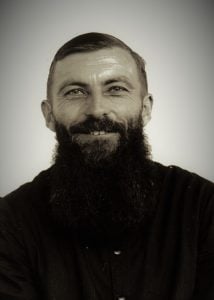
In 1948-1949, he was at the Oblate novitiate at La Brosse-Montceaux. At the Oblate Scholasticate in Solignac he did six years of philosophical and theological studies. On September 29, 1952, he made his perpetual oblation. On July 4, 1954, he was ordained a priest at Solignac Abbey. His marching order for Laos is dated June 11, 1955.
Having arrived in Laos in November, 1955, he was sent shortly afterwards to Xieng Khouang. After a year, perplexed by the multiple languages and dialects of this region, he asked to spend some months in the Mekong valley to better familiarize himself with the official Lao language, spoken on the plain. At the end of 1957, he reached his final posting at Ban Pha in the mountains. There were several Christian villages of the Kmhmu’ language in the area, as well as a large territory to look into where the Gospel had not yet penetrated. During the following three and a half years, he visits the villages entrusted to him, at two, three or five hours walking distance, in all weather, on impossible paths. In one of his letters he writes:
“From July 1, 1959, until July 1, 1960, there were 73 baptisms of which 37 adults. About 3,000 persons have come seeking care; at least 3,000 kilometers on foot, carrying a backpack. Some days, it’s hard, especially when my health is not so great, but I am very happy to be working in this area.”
On April 18, 1961, Fr. Louis Leroy was praying in his poor church. A detachment of guerilla soldiers came looking for him. According to the villagers, he knew that his departure would be final: bareheaded and barefoot, he followed the soldiers on the uneven path.
According to a witness, Louis Leroy was interrogated, beaten and his face burned until it was disfigured. A bit later, some shots were heard in the forest. Many years later, a non-Christian of the village would tell a Laotian priest: “They killed him.” According to comments gathered later, Louis could have easily escaped. When the royal troops abandoned the village of Ban Pha, the soldiers insisted that he leave with them. He calmly refused, saying that it was his duty to stay with his people, according to orders received from his superiors. He added: “I am ready to die for the Lord.”
Father Michel Coquelet
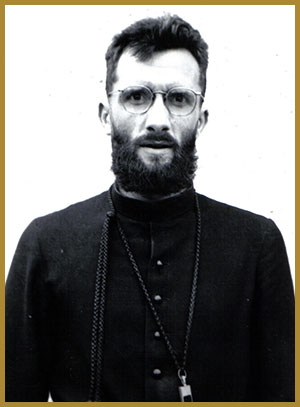
Michel Coquelet entered the novitiate of the Missionary Oblates of Mary Immaculate at La Brosse-Montceaux in 1948. In September, 1949, after having pronounced his religious vows, he was sent to the Oblate scholasticate, the Solignac Abbey in Haute-Vienne. There he did there the required studies in philosophy and theology, and prepared himself in an intense spiritual and community life for the future he had chosen: to become a priest and a missionary religious. Michel would stay at Solignac until his departure for Laos in 1957, except for 18 months of military service, from January 1952 until June 1953. On June 29, 1954, Michel made his perpetual oblation as an Oblate of Mary Immaculate. On February 19, 1956, he was ordained a priest in the abbey church at Solignac.
On January 25, 1957, Fr. Coquelet received his marching papers. He flew off to Laos, where Vientiane would welcome him on April 1, 1957. His Oblate superiors in Laos immediately made him a faculty member at the Minor Seminary of Paksane (1957-1958). At the same time, he began to study the Lao language. At the end of 1958, Michel received an obedience for the mission of Xieng Khouang. Three years later, in 1961, Fr. Coquelet lived in Phôn Pheng, a remote Christian village near Tha Vieng in the Province of Xieng Khouang, called Ban Houay Nhèng. There he took care of a rather large area.
On Sunday, April 16, 1961, Fr. Coquelet celebrated the Second Sunday after Easter with his Christian community. On Monday the 17th, he took his leave: he had been called to care for an injured person at Ban Nam Pan. He left by bicycle. Not far from Xieng Khong, Michel was stopped by the guerillas. Leaving the bicycle behind, the soldiers took him along the road toward Ban Sop Xieng. A little away from the road, they told him to dig his grave. Michel threw the shovel aside. He would die standing up, fearless, for Christ and for the Laotians. Fr. Michel Coquelet was killed without a trial and without mercy. He was not yet 30 years old.
Father Vìncent L’Hénoret
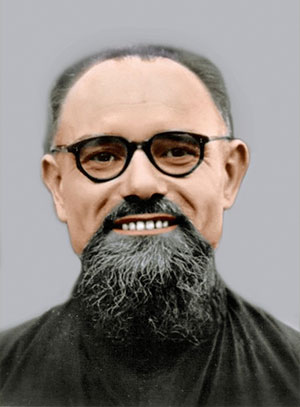
At the end of his studies, he asked to consecrate his life to God, in view of the missions, in the Oblate family. He would do his novitiate in the same house, at Pontmain. For his studies in philosophy and theology, he was sent to La Brosse-Montceaux. There, he personally saw the drama of July 24, 1944: the summary execution of five Oblates of his community by Nazi soldiers. He and his confreres were deported to a prison camp at Compiègne; but were liberated shortly thereafter, at the beginning of September, by the advancing allies.
Upon his return to La Brosse, Vincent made his perpetual oblation on March 12, 1945, and was ordained a priest on July 7, 1946. Peace had returned. Vincent L’Hénoret is now ready to leave for the missions. On August 10, 1946, he is sent officially to Laos to proclaim the Gospel.
His first stay in Laos was in the area of Paksane. There he needed to learn the language, the customs, and the method of missionary activity. He is then sent to be in charge at Nong Buoa. There he found a strong community of 400 Christians. In November, 1957, he joined the missionary team at Xieng Khouang. His posting was at Ban Ban. Only a handful of Christians lived there. In the neighborhood, however, several villages of Thaï Deng refugees coming from the province of Sam Neua had settled, since 1952-1953. The pastoral and missionary work was not easy: these people had suffered for years the vagaries of endemic war which had hardly spared them. There was much to do, especially in giving self-confidence to dislocated families.
In the final months of 1960, the dissident regime installed in Sam Neua extended its grip over the whole region. The system was organized with its sequence of indoctrination meetings and barriers to the free movement of persons. On Wednesday, May 10, 1961, Fr. L’Hénoret went to celebrate the feast of the Ascension at Ban Na Thoum, a village some 7 km away. On Thursday morning, May 11, he was seen leaving Na Thoum by bicycle at seven in the morning. A little later, between Ban Na Thoum and Ban Faï, he was stopped by three men wearing guerilla uniforms. A peasant woman who was working in her field was witness to the first part of the scene: “Father brought out a paper, his pass, undoubtedly. That seemed to satisfy the soldiers, because the Father got on his bicycle again and took to the road.” The peasant woman did not see what followed, but, a little later, she heard some shots. She returned to the village, found the bicycle and then saw a body barely covered in a trench. Terrified, she did not dare say or do anything for the moment. The next day, a little group of villagers went to the site. At about 1500 meters from the village, they saw a large pool of blood on the road and discovered the body of Fr. L’Hénoret which had been carried to a ditch further into the forest. On Saturday, they went to get Fr. Khamphanh, and proceeded with him to give a dignified but quick burial, without dawdling because all remained aware of the danger. A cross was placed on the grave. There was never any explanation given for the murder. The military authorities stationed in the region simply denied everything. According to a witness, the new masters demolished their church and forbade the Christians to meet. The younger generations were no longer able to be catechized. They only know the school and the propaganda, and they do not know about the Christian religion. A witness later said: “I believe he was killed out of hatred for religion and, especially, of the Catholic religion. “
Father Jean Wauthier
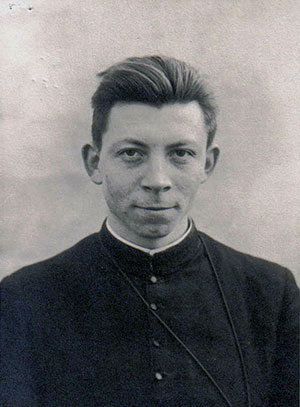
After his ordination, he was assigned to the mission of Vientiane in Laos in 1952. Upon his arrival in the country on October 26, 1952, he was immediately sent to serve at the mission among the poorest, the Kmhmu’. He would almost always be with people from the same villages, whom he followed through their displacements during the war years. In 1961, the whole village was forced to retreat to the edge of the Plain of Jars, to Ban Na first, and then to Hin Tang. From 1961-1963 he did an internship of two years at the minor seminary of Paksane. Every Saturday he left the seminary for Sunday ministry in the villages. In December, 1963, he returned to the ministry among the Kmhmu’. He spent most of his last years in Hin Tang and devoted himself to the difficult task of an equitable distribution of humanitarian aid. He defended the poor Kmhmu’ without favoring them, because he knew how to be of service to all. His activity displeased the Special Forces, who presumed they should be served first. Jean is now aware that his life is threatened.
On the night of December 16 – 17, 1967, Jean Wauthier was killed at close range. He had come to spend two nights in the tiny village of Ban Na, to see the catechumens. At 800 meters from the house where he stayed, there was a small military post on a hill. Those who sought his life feigned a guerrilla attack. At once he arose, gathered the two children who were staying with him and a couple of catechumens, and went down with them to a flowing stream 200 or 300 meters below the village. He sheltered them in a gully there. He moved away to assess the situation. A shot rang out. Hit at the base of the neck, Jean Wauthier begged his attackers, hidden behind a small hedge, “Why do you shoot me? Stop! I am really hurt.” “Stop talking!” was the reply. And the shooting resumed. Shot three times in the chest, he collapsed and died.
The day after the death of Fr. Jean Wauthier, one of the catechists would write to his parents: “Fr. Jean died because he loved us and did not want to abandon us.” Fr. Wauthier’s body was taken to Vientiane. He rests in Laotian earth, in the Catholic cemetery of the town.
Father Joseph Boissel
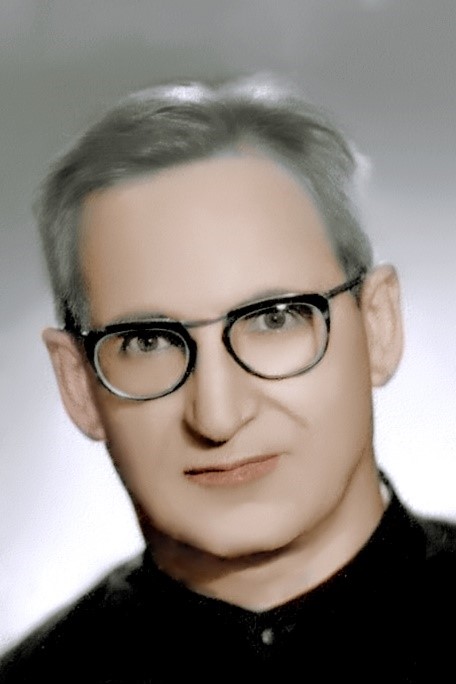
Fr. Boissel was part of the pioneer group of the Oblate Mission in Laos. Having arrived in the country in October, 1938, he quite soon was sent toward the area of Xieng Khouang where evangelization was just beginning. Without making any conversions, he had aroused a real feeling of friendship, especially among the Hmong. In March, 1945, the Japanese attacked Laos. On June 1, Joseph Boissel was captured and was taken to Vinh, Vietnam. Back in Laos in 1946, Joseph again made contact with the Hmong. The mission of Nong Ether was sacked and devastated. The material conditions were very precarious. Fr. Boissel himself planted rice to live on. In 1958, Fr. Boissel took up a new phase of his missionary life: he was assigned to the district of Paksane where he would work until his final day. He was, first of all, in charge of a rice-producing village of Nong Veng; then, beginning in 1963, he moved to Ban Na Chik at the 4 km mark of Paksane toward Pak Kading. He circulated among the villages, despite his eyesight, defective because he had completely lost the use of one eye. In those years, taking the road was always risky: from late March, 1969, the threat of the guerrillas had widened so much that he had to forego celebrating Holy Week in these villages. Only in early June, did Fr. Boissel dare to venture again on this road of ambushes. Every Saturday at the end of the day, Fr. Boissel went to one of the villages and came back on Sunday around noon.
On Saturday, July 5, 1969, he decided to go to Hat I-Êt, a village of Kmhmu’ refugees a good 20 kilometers from Paksane, going up along the River Nam San. Setting out around four in the afternoon, he took two nuns with him. As usual, they were to help him with the visits, the care of the sick and the religious service. The following is told by one of the two nuns: “Before arriving at the village, I heard a burst of gunfire aimed at us. The tires blew out and I was hit in the hand. A second burst of gunfire and the other nun was hit in the head. Fr. Boissel was hit in the head, near the mouth and in the skull. The jeep went into a ditch and turned over. Father’s glasses were broken; he died on the spot. His big eyes were open. All three of us were completely covered with blood. I saw three young Vietnamese soldiers going around the vehicle three times. They said: `Let’s burn the vehicle and its occupants!´ They moved away and threw a grenade at the car. The grenade exploded. I don’t know how long we stayed like that in the car. The grenade had deafened us. Finally some people arrived to pick us up. Father’s body had been burned to the point that his face was totally unrecognizable. The other nun, hit in the head, remained mentally handicapped as a result of the attack.” – Fr. Boissel died for his faith in Jesus Christ, because of a desire to see the Catholic religion disappear. It was known that Fr. Boissel went to one village every Saturday at around 4 o’clock. There was hatred; for foreigners, for priests, for the Catholic religion.
